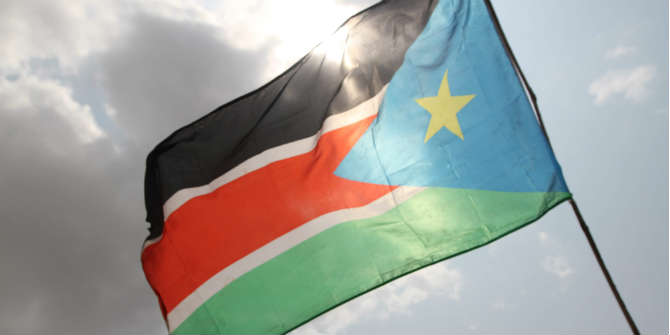#RhodesMustFall: Nibbling at Resilient Colonialism in South Africa is timely, balanced and informative, but aspects of the book will leave the reader craving more says Simukai Chigudu.
In 2015, a wave of student protests erupted across South African universities. They overwhelmingly expressed discontent at the failure to ‘decolonise’ tertiary education 21 years after the dawn of the democratic era. Beginning at the University of Cape Town (UCT) under the moniker Rhodes Must Fall (RMF) and then succeeded by cognate movements at different universities, these protests ignited some of the most heated and pertinent public debates in the country about history, race, entitlement and citizenship.
In this account of RMF, Francis B. Nyamnjoh offers an urgent and important analysis of the drivers, logics, historical bases, future prospects and potential pitfalls of student activism premised on the idea of ‘decolonising’ education. As a professor of anthropology at the University of Cape Town and an accomplished writer on the politics of education in Africa, Nyamnjoh is well placed to offer an incisive take on the movement.
 He leads with a portrait of Cecil John Rhodes whose dubious legacy is etched in UCT’s history and institutional memory. As he argues, ‘Rhodes took over, ruled, developed and exploited for his personal profit and that of Britain the lands and bodies of those he conquered, turning them into amakwerekwere [a pejorative term for outsiders] on their own native soil, their homeland’ (p28). The comprehensive view Nyamnjoh provides of Rhodes’ imperialism and its attendant history of racialised alienation, exploitation and dispossession offers a powerful context for enduring black pain and trauma that the memorialisation of Rhodes evokes. This is why a statue of Rhodes, at the heart of UCT’s campus, was such a cogent signifier of white privilege and black oppression.
He leads with a portrait of Cecil John Rhodes whose dubious legacy is etched in UCT’s history and institutional memory. As he argues, ‘Rhodes took over, ruled, developed and exploited for his personal profit and that of Britain the lands and bodies of those he conquered, turning them into amakwerekwere [a pejorative term for outsiders] on their own native soil, their homeland’ (p28). The comprehensive view Nyamnjoh provides of Rhodes’ imperialism and its attendant history of racialised alienation, exploitation and dispossession offers a powerful context for enduring black pain and trauma that the memorialisation of Rhodes evokes. This is why a statue of Rhodes, at the heart of UCT’s campus, was such a cogent signifier of white privilege and black oppression.
Nyamnjoh thoughtfully makes the case for a movement to decolonise education noting that education in Africa ‘is still the victim of a resilient colonial and colonising epistemology’ (p69). He points out that tertiary education on the continent tends to dismiss local histories as parochial; local struggles as subordinate to global concerns; and local languages, customs, and knowledge systems as backward and unworthy of serious intellectual inquiry. Such an orientation is antithetical to fostering the conviviality – ‘the spirit of togetherness, interpenetration, interdependence and intersubjectivity’ (p69) – so desperately needed to heal and unify South Africa’s wounded and divided society. It is here that the demands of RMF resonate most powerfully.
However, Nyamnjoh does not subscribe to a romanticised view of protest. He is at pains to give attention to the personal and political conflicts that occurred within and as a result of the RMF movement. For instance, he offers an even-handed appraisal of the leadership of Chumani Maxwele. He praises Maxwele for his courage and political acumen, especially in using human faeces to desecrate the Rhodes statue and therefore underscore the depth of poverty, injustice and inequality that the statue belies. In Maxwele’s own words: ‘We want white people to know how we live. We live in poo. I am from a poor family; we are using portaloos. Are you happy with that?’ (p77). At the same time, Nyamnjoh brings forth the charges of rape levelled against Maxwele and gives space to discuss the dynamics of patriarchy and transphobia that permeated RMF.
Importantly, Nyamnjoh argues that movements like RMF risk propagating a zero-sum mentality in which further divisions are created in the battle for decolonisation and in claims to restitution: between black and white, the middle and working classes, South Africans and foreign nationals. The speed and reach of RMF and then Fees Must Fall may have compromised the depth of the movements. For Nyamnjoh this is evident in their relative inattention to a ‘disposition of mutual accommodation’ (p205) for all who inhabit South Africa. Therefore he concludes that ‘for existing colonial statues and monument to signify anything but oppression and dispossession, they would have to be re-articulated, recalibrated and reconfigured into multi-cultural symbols of reconciliation’ (p207). This calls for greater humility and awareness of the sensibilities and concerns of ‘the various shades of the rainbow nation’ (p207).

Photo Credit: Desmond Bowles via Flickr (http://bit.ly/27dUE6W) CC BY-SA 2.0
Nyamnjoh’s book is written with clarity and panache. His account is timely and informative. In an impressively short time, he has assimilated a vast amount of material on RMF and provided a clear chronology and analysis of its emergence and trajectory. His critique is balanced throughout and his claims are, for the most part, substantiated. Nevertheless, aspects of the book will leave the reader craving more. For a work by an anthropologist, the book is thin where it comes to a more ethnographic account of RMF. One wants an insider’s view: a greater understanding of RMF’s participants, their modes of engagement, practices of agenda setting and reflections on the movement. Furthermore, the theoretical observations made by Nymanjoh could have been even more effective if linked to the writing and perspectives of other scholars who have been documenting the RMF movement. The work of Sabelo Ndlovu-Gatsheni comes to mind. His presentation on RMF at the London School of Economics, for example, placed the movement with a genealogy of student protest in South Africa and went further in theorising the politics of decolonisation. These insights would add richly to Nyamnjoh’s account.
In summary, this is a compelling first monograph on RMF. It is highly readable and engaging and will easily be of interest to a wide range of observers interested in RMF and the politics of student protest in South Africa. For scholars, this book will be foundational to further work on RMF and it provides a compendious list of references and sources for deeper research. As a participant in the Rhodes Must Fall movement in Oxford and as a scholar researching African history and politics, I recommend this book without hesitation.
#RhodesMustFall: Nibbling at Resilient Colonialism in South Africa by Francis B Nyamnjoh. 2016. Langaa RPCIG, Cameroon.
The views expressed in this post are those of the authors and in no way reflect those of the Africa at LSE blog or the London School of Economics and Political Science.
Simukai Chigudu is a DPhil (PhD) candidate in International Development at the University of Oxford where he is a Hoffman-Weidenfeld scholar. Follow him on Twitter @SimuChigudu.





